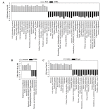Subgingival dysbiosis in smoker and non‑smoker patients with chronic periodontitis
- PMID: 28260061
- PMCID: PMC5364964
- DOI: 10.3892/mmr.2017.6269
Subgingival dysbiosis in smoker and non‑smoker patients with chronic periodontitis
Abstract
Periodontitis is one of the most common oral inflammatory diseases, and results in connective tissue degradation and gradual tooth loss. It manifests with formation of periodontal pockets, in which anaerobic and Gram‑negative bacteria proliferate rapidly. Consequently, alteration of the subgingival microbiota is considered the primary etiologic agent of periodontitis. Previous studies have reported that smokers are at increased risk of periodontal disease, in both prevalence and severity, indicating that smoking is a risk factor for the onset and progression of the pathology. In the present study, 16S rRNA sequencing was employed to assess the subgingival microbiota in 6 smoker patients with chronic periodontitis, 6 non‑smoker patients with chronic periodontitis and 8 healthy controls. The results demonstrated significant alterations in the microbial structure of periodontitis patients. High relative abundance of Parvimonans, Desulfubulbus, Paludibacter, Haemophilus, and Sphaerochaeta genera characterized subgingival microbiota of periodontitis patients, both smokers and non‑smokers. Due to the high precision and sensitivity of the 16S rRNA sequencing method, analysis for low‑abundant genera (including Pedobacter, Granulicatella, Paracoccus, Atopobium, Bifidobacterium, Coprococcus, Oridobacteriu, Peptococcus, Oscillospira and Akkermansia) was feasible, and revealed novel phylotypes associated with periodontitis. Of note, a major microbial community alteration was evident in smoker patients, suggesting an association between smoking and severity of subgingival dysbiosis. The present study confirmed that chronic periodontitis is a polymicrobial disease where changes in the equilibrium of subgingival microbiota contribute to severity of pathology.
Figures



Similar articles
-
Subgingival microbiome in smokers and non-smokers in Korean chronic periodontitis patients.Mol Oral Microbiol. 2015 Jun;30(3):227-41. doi: 10.1111/omi.12086. Epub 2014 Nov 19. Mol Oral Microbiol. 2015. PMID: 25283067
-
The Subgingival Microbiome of Periodontal Pockets With Different Probing Depths in Chronic and Aggressive Periodontitis: A Pilot Study.Front Cell Infect Microbiol. 2018 May 1;8:124. doi: 10.3389/fcimb.2018.00124. eCollection 2018. Front Cell Infect Microbiol. 2018. PMID: 29765908 Free PMC article.
-
Dysbiosis and alterations in predicted functions of the subgingival microbiome in chronic periodontitis.Appl Environ Microbiol. 2015 Jan;81(2):783-93. doi: 10.1128/AEM.02712-14. Epub 2014 Nov 14. Appl Environ Microbiol. 2015. PMID: 25398868 Free PMC article.
-
Microbial signatures of health, gingivitis, and periodontitis.Periodontol 2000. 2021 Jun;86(1):57-78. doi: 10.1111/prd.12362. Epub 2021 Mar 10. Periodontol 2000. 2021. PMID: 33690899 Review.
-
Metagenomic sequencing provides new insights into the subgingival bacteriome and aetiopathology of periodontitis.J Periodontal Res. 2021 Apr;56(2):205-218. doi: 10.1111/jre.12811. Epub 2021 Jan 6. J Periodontal Res. 2021. PMID: 33410172 Review.
Cited by
-
Athlete's Passport: Prevention of Infections, Inflammations, Injuries and Cardiovascular Diseases.J Clin Med. 2020 Aug 6;9(8):2540. doi: 10.3390/jcm9082540. J Clin Med. 2020. PMID: 32781561 Free PMC article.
-
The composition of microbial communities in inflammatory periodontal diseases in young adults Tatars.AIMS Microbiol. 2021 Jan 27;7(1):59-74. doi: 10.3934/microbiol.2021005. eCollection 2021. AIMS Microbiol. 2021. PMID: 33659769 Free PMC article.
-
Antibacterial properties and abrasion-stability: Development of a novel silver-compound material for orthodontic bracket application.J Orofac Orthop. 2024 Jan;85(1):30-42. doi: 10.1007/s00056-022-00405-7. Epub 2022 Jul 18. J Orofac Orthop. 2024. PMID: 35849137 Free PMC article.
-
Methicillin-Resistant Staphylococcus aureus: Risk for General Infection and Endocarditis Among Athletes.Antibiotics (Basel). 2020 Jun 18;9(6):332. doi: 10.3390/antibiotics9060332. Antibiotics (Basel). 2020. PMID: 32570705 Free PMC article. Review.
-
Subgingival Microbiota Profile in Association with Cigarette Smoking in Young Adults: A Cross-Sectional Study.Dent J (Basel). 2021 Dec 11;9(12):150. doi: 10.3390/dj9120150. Dent J (Basel). 2021. PMID: 34940047 Free PMC article.
References
MeSH terms
Substances
LinkOut - more resources
Full Text Sources
Other Literature Sources

